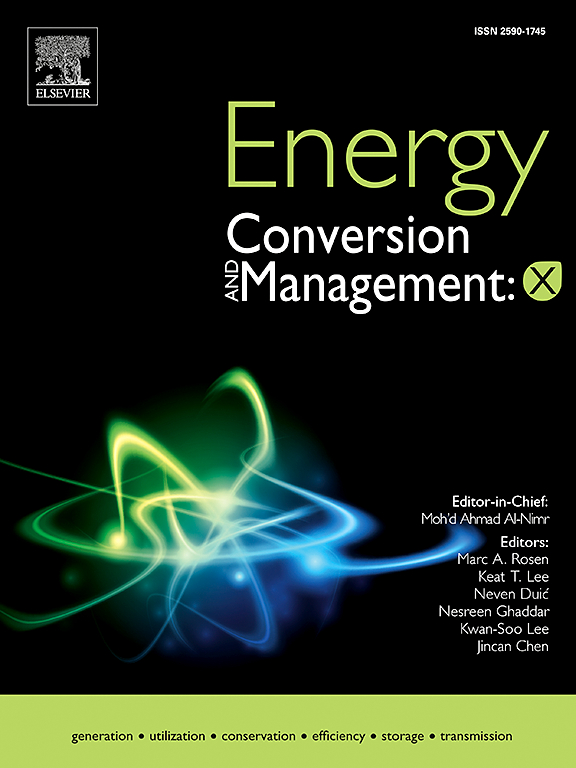Comparative market price and emission driven electricity dispatch analysis for sCO2 cycle based thermally integrated pumped thermal energy storage system
IF 7.1
Q1 ENERGY & FUELS
引用次数: 0
Abstract
Large-scale energy storage is essential for integrating increasing shares of renewable energy into power grids. Pumped Thermal Energy Storage (PTES), particularly Thermally Integrated PTES (TI-PTES), offers advantages such as long lifespan, fast response, and flexibility, along with external heat source integration. Traditionally, PTES dispatch studies focus on maximizing profitability, which often leads to energy storage from CO2-emitting sources rather than purely from renewables. This study investigates the optimal dispatch strategy for a supercritical carbon dioxide (sCO2) thermal cycle-based TI-PTES across various European markets using a Mixed Integer Linear Programming (MILP) model. The primary objective is to evaluate the economics of TI-PTES optimized for CO2 emission minimization and compare it with conventional profit-maximizing dispatch strategies based on electricity market prices.
For selected EU energy markets, key indicators such as payback period, net present value (NPV), levelized cost of electricity (LCOE), and displaced CO2 emissions are analyzed for price-based vs. CO2 emission-based dispatch to assess the financial viability and environmental impact of TI-PTES. Study shows annual round-trip efficiency of 105 % for Finland and 101 % for Germany, as compared to the 112 % of the electric RTE set for the model. The payback periods for only Germany comes out to be achievable during the span of the plant life of 25 years under the current market price scenarios. However, with increased volatility from 20 to 100 %, the payback period for the same market can decrease 20–60 % of the current value. Similarly, the study further proposes a novel hybrid dispatch strategy that incorporates both economic profitability and emission minimization by assigning appropriate weights to each objective. The optimal weighting varies for each energy market to achieve the most effective results. The hybrid dispatch approach positions TI-PTES as both an economically and environmentally viable solution for energy storage and grid integration.
基于sCO2循环的热集成抽水蓄能系统的比较市场价格和排放驱动电力调度分析
大规模的能源储存对于将越来越多的可再生能源纳入电网至关重要。抽水蓄能(PTES),特别是热集成PTES (TI-PTES),具有使用寿命长、响应速度快、灵活性好以及外部热源集成等优点。传统上,PTES调度研究的重点是利润最大化,这往往导致从二氧化碳排放源而不是纯粹的可再生能源中储存能量。本研究使用混合整数线性规划(MILP)模型研究了欧洲不同市场超临界二氧化碳(sCO2)热循环TI-PTES的最优调度策略。本文的主要目标是评估优化后的TI-PTES的经济性,并将其与基于电力市场价格的传统利润最大化调度策略进行比较。对于选定的欧盟能源市场,分析了基于价格和基于二氧化碳排放调度的关键指标,如投资回收期、净现值(NPV)、平准化电力成本(LCOE)和替代二氧化碳排放,以评估TI-PTES的财务可行性和环境影响。研究表明,芬兰的年往返效率为105%,德国为101%,而该模型的电动RTE设定为112%。在目前的市场价格情况下,只有德国的投资回收期在电厂25年的寿命期间是可以实现的。然而,随着波动性从20%增加到100%,同一市场的投资回收期可能会减少当前价值的20 - 60%。同样,研究进一步提出了一种新的混合调度策略,通过为每个目标分配适当的权重,将经济盈利和排放最小化结合起来。为了达到最有效的结果,每个能源市场的最优权重是不同的。混合调度方法将TI-PTES定位为能源存储和电网整合的经济和环境可行的解决方案。
本文章由计算机程序翻译,如有差异,请以英文原文为准。
求助全文
约1分钟内获得全文
求助全文
来源期刊

Energy Conversion and Management-X
Multiple-
CiteScore
8.80
自引率
3.20%
发文量
180
审稿时长
58 days
期刊介绍:
Energy Conversion and Management: X is the open access extension of the reputable journal Energy Conversion and Management, serving as a platform for interdisciplinary research on a wide array of critical energy subjects. The journal is dedicated to publishing original contributions and in-depth technical review articles that present groundbreaking research on topics spanning energy generation, utilization, conversion, storage, transmission, conservation, management, and sustainability.
The scope of Energy Conversion and Management: X encompasses various forms of energy, including mechanical, thermal, nuclear, chemical, electromagnetic, magnetic, and electric energy. It addresses all known energy resources, highlighting both conventional sources like fossil fuels and nuclear power, as well as renewable resources such as solar, biomass, hydro, wind, geothermal, and ocean energy.
 求助内容:
求助内容: 应助结果提醒方式:
应助结果提醒方式:


